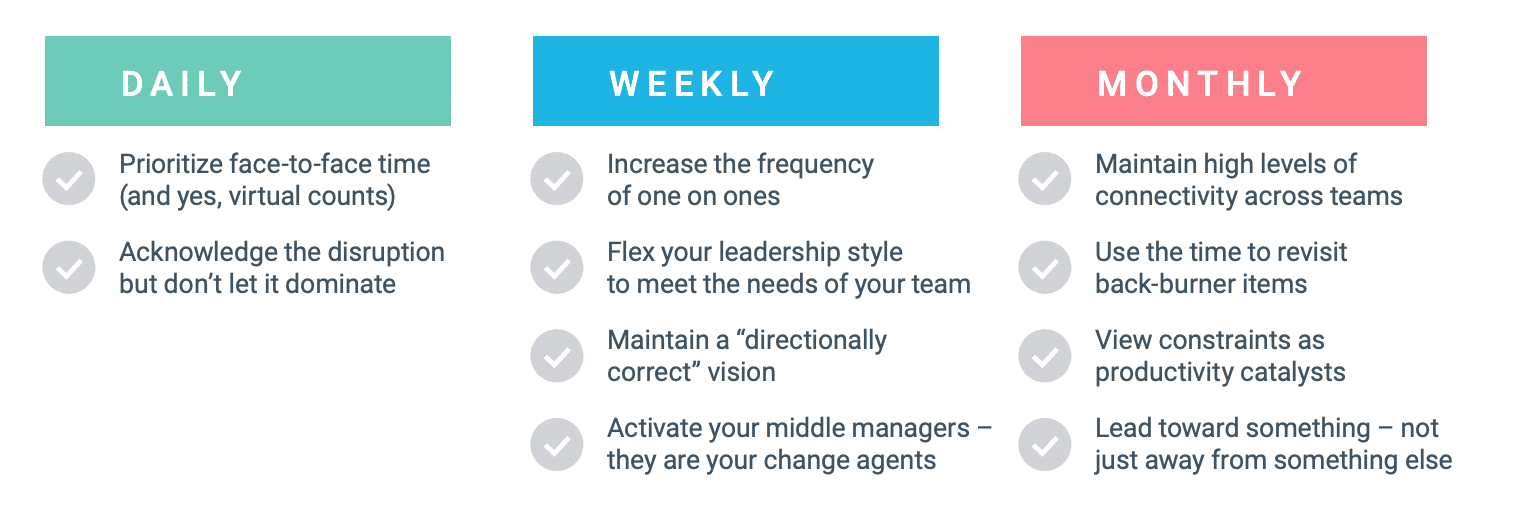By Dr. Summer Salomonsen, Head of Cornerstone Studios
Now that we’re one year into the pandemic, some people may be struggling to stay engaged, connected and productive at work. The following are some tips from Cornerstone our managers found effective in supporting their teams.
Here are some key ways to help you bring out the best in your workforce during this or any other time of great change:

Daily: Communicate frequently and authentically
Prioritize face-to-face time.
Turn on your webcams! Meeting face-to-face is one of the most powerful ways to bridge the remote divide. To encourage employees to use video, create an environment where it’s “safe” to do so. That means making sure employees aren’t worried about clothes, hair, or a messy desk. No one is at their finest right now, and that’s OK! The power of connection is more important than “perfection.”
Tip: Make time for video meetings: whether it’s a semi-regular virtual happy hour or quick daily pulse check, make sure you are visible to your team on a regular basis—and that they’re visible to you, too!
Acknowledge the disruption but don’t let it dominate.
COVID-19 has affected everyone, in every country, so there’s no point in pretending it’s not a major factor in everyone’s lives. How can you create balance? Consider using the first few minutes of every meeting for a brief “pulse check.” A quick “How is everyone?” goes a long way.
Tip: Set expectations ahead of time. Add pulse checks into the agenda, so employees know there is a start and a stop point for sharing.
Weekly: Lean into leadership
Increase the frequency of one-on-ones.
More frequent one-on-one meetings create the real-time connection that is so absent from remote working situations. Employees may also be more comfortable sharing in a more private setting. Just like group meetings, these one-on-ones should start with a brief “How are you? Tell me what’s real in your life” and move on quickly to the work at hand.
Tip: What is the right level of frequency? It varies depending on department and role but consider increasing it by the power of four. For example, if you have been meeting with individual team members twice a month, start meeting twice a week for 15-30 minutes. At minimum, you should commit to weekly 1:1s.
Adjust your leadership style.
Leadership styles vary greatly. But in the midst of a global disruption, certain leadership qualities may resonate more with employees. This doesn’t mean you have to throw out your entire leadership style; rather, look at what’s most effective at driving productivity and value during this time of uncertainty.
If you don’t normally have a “personal” leadership style, over-indexing on empathy or compassion may feel inauthentic to you. One way to balance leading in a way that motivates employees and remains authentic is finding the right channel and frequency to connect. For example, consider sharing anecdotes and/or pictures of your home life via group communication channels. During times of uncertainty, you’ll want to prioritize the needs of your team over your own leadership style preference.
Tip: Leading during global disruption requires compassion, empathy, and a commitment to personal interactions. Take a deeper look at the makeup of your leadership style and consider what your team might need now to do their best work. More frequent check-ins? More flexible work hours to accommodate the new realities of family life? Increased independence on projects?
Maintain a “directionally correct” vision.
During a crisis, it’s typical for objectives and vision to shift. But don’t let that discourage you. Instead – focus on the agility you’ll need to drive towards a vision that is “directionally correct.”
Tip: During any global disruption, you may have to do more to help maintain the vision. Internal marketing can help you build grassroots support for any changes, and frequent communication with team leaders can ensure continued alignment.
Activate your middle managers.
They are your change agents! According to research by Dr. Behnam Tabrizi of Stanford University, organizations that successfully navigated change did so by empowering middlelevel managers (MLMs). Managers two degrees removed from the executive suite were the most effective in driving change. MLMs “[serve] as levers of change, influencing those above and below them in the corporate hierarchy,” says Tabrizi.i But they need support to do so: Activate your middle managers by tasking them with helping you maintain vision, drive new projects, and motivate and influence your workforce.
Tip: According to Tabrizi, too many middle-level managers are “cautious and unsure of their authority.”ii Engage and empower them by reshaping their roles. Tabriz recommends using “triple-A” leadership principles: Align their values with change goals, give them authorship of innovation plans, and enable them to take action and responsibility for the success of their initiatives.
Monthly: Plan for the future
Maintain high levels of connectivity throughout the disruption.
As the “new normal” becomes simply “normal,” it may seem sensible to reduce communication frequency. But experts caution that it’s vital to continue to maintain high levels of connectivity throughout the duration of this or any global disruption. Uncertainty, social isolation, and lack of community will only intensify with time; employees will need increasing opportunities for social interaction, direct support from managers, and ongoing direction and structure.
Tip: Through times of disruption and change, what worked yesterday may not work today, and what one team or person needs may not work for another. Send out a survey or take a quick poll at an all-hands to show your team and direct reports you’re willing to do what works for them. Maintain the connective tissue of your team through a meaningful meeting cadence (webcams on!) and relevant email report-out process.
Use the time to revisit back burner items.
Current projects may be on hold or permanently cancelled. But that doesn’t mean there isn’t work to be done. Every leader has a list of back-burner items, projects that never make it off the wish list. Whether it’s a process overhaul or categorizing assets, now is the time to evaluate and bring forward those “we never had the time” projects. You may be surprised to discover they have greater relevance now in a changing environment.
Tip: What projects did you always wish your teams could focus on, if only there were more hours in the day? Take advantage of this time to start or continue with projects that have always been on the back burner.
View constraints as productivity catalysts.
The expanded timeline of the current disruption—a slow economic reopening, uncertainty on vaccine development timelines—mean all future roadmaps have to change. The good news? The biggest constraints have the biggest potential for innovation. By being flexible and creative—and using restrictions as a springboard for innovation—companies can continue to deliver value through the pandemic and beyond.
Tip: It’s said that creativity flourishes amid limits. Empower your teams to re-imagine workflows or processes through the lens of new constraints. Assign a “productivity challenge” to several employee groups over the course of a week and wrap with a 2-hour pitch session on a Friday. You may be surprised by what they come up with.
Lead toward something.
The biggest deception is that, as leaders, we only have to get through this crisis and then everything will go back to normal. But this is the new normal. Global disruption is a harsh reminder that being a leader doesn’t just require guiding teams through the easy times. It’s also being ever ready to navigate the difficult times while simultaneously creating new visions for the future.
Tip: Realize that this current disruption will continue to impact organizations in the months and years to come. Start planning for that time, be it six months or two years from now. Set aside 30 minutes each week for forward-thinking with your key team players. Start with a collective brainstorm around what may definitely change in your function, and then maneuver the time into more tactical revisions of process and procedures.
Thriving in Times of Disruption
Helping employees through times of great change requires elevated levels of communication, leadership, and planning. By acting daily, weekly, and monthly to motivate and reassure the workforce, leaders can ensure employees—and the organization—continue to thrive amid global disruption. Leadership development is an ongoing process, but a critical one for empowering your people to address today’s crisis and tomorrow’s demands. By implementing these strategies and tips, you can be the agile leader your organization needs to navigate changing circumstances—and you’re not alone.

